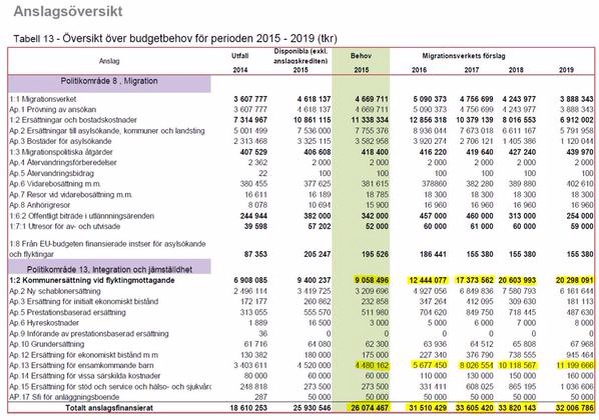When open hearts lead to ruin
http://swedenreport.org/2015/02/26/when-open-hearts-lead-to-ruin/

Typical Swedish taxpayer
A new study has just been released on the cost of Swedish asylum immigration. Joakim Ruist, economic researcher at Gothenburg University, has calculated the net of the direct costs incurred by Sweden’s extremely generous immigration policy and came up with the number 50 billion SEK for 2015.
These are just the direct costs, and only for asylum seekers. There is also about the same amount of immigration made up of relatives to previous arrivals. In theory, the latter are supposed to guarantee the livelihood of the relatives, but thanks to a hodgepodge of exceptions in the rules, that requirement only applies to a tiny fraction. The reality is that the vast majority of relatives go straight into welfare upon arrival. There doesn’t seem to be any reliable numbers on how many additional billions this entails.
Sweden is a tiny country with a total annual tax collection of 820 billion SEK (2013) already running at a hefty deficit. The cost of immigration is projected to increase sharply in the years ahead, as illustrated by the budgeting forecast of the immigration bureau as well as the direct reimbursement to the municipalities.

Swedish immigration bureau budget forecast & municipal costs of immigration
In 2009, the immigration bureau had a total budget of 2 billion SEK even. By 2014, the number had increased to 3,6 billion, with a projected bump to 4,6 billion for 2015 and hitting 5,1 billion by 2016. After that the curve is expected to flatten out and start decreasing, but considering the history of sharp upwards revisions (twice in 2014 alone) this seems unlikely.
But that was just the cost of the clerks handling the paperwork. Looking at the state reimbursement to municipalities for direct immigration costs, the scope and steep curve is sobering. The 2010 budget had a post of 4,9 billion for this purpose.
- 2014: 18,6 billion SEK (actual)
- 2015: 26 billion SEK
- 2016: 31,5 billion SEK
- 2017: 33,6 billion SEK
Despite having less than 2% of the European population, Sweden already absorbs about 20% of refugees. And that is before the projected hikes.
What does this mean for Swedish economy in the years ahead? Hard to say, since even discussing any kind of limit to costs associated with immigration is taboo. It is the one unique government expenditure that has a carte blanche; everything else has to shape itself around budget posts 8 and 13, shown above, be it in the shape of tax hikes, deficit spending or cutbacks on other services. Or a combination of the three.
Now, with just a Bachelor’s degree in Finance, I make no claims of being any kind of authority on the matter. But as an investor, I’m used to sizing up stocks before making a decision. And personally, I would be rather bearish on Sweden Inc. at this point.






































No comments:
Post a Comment